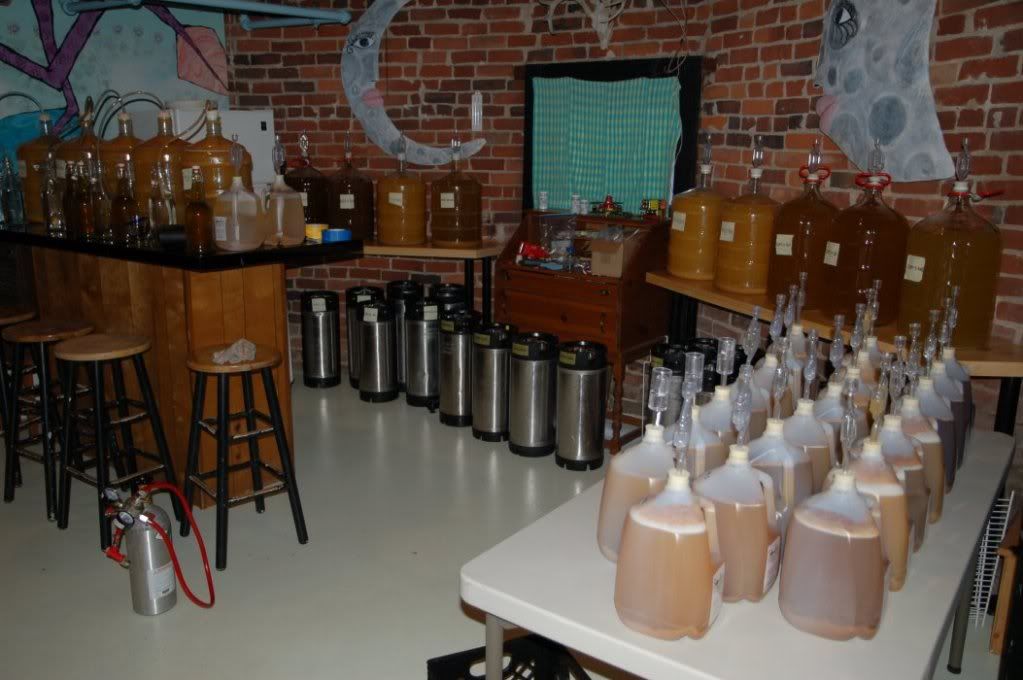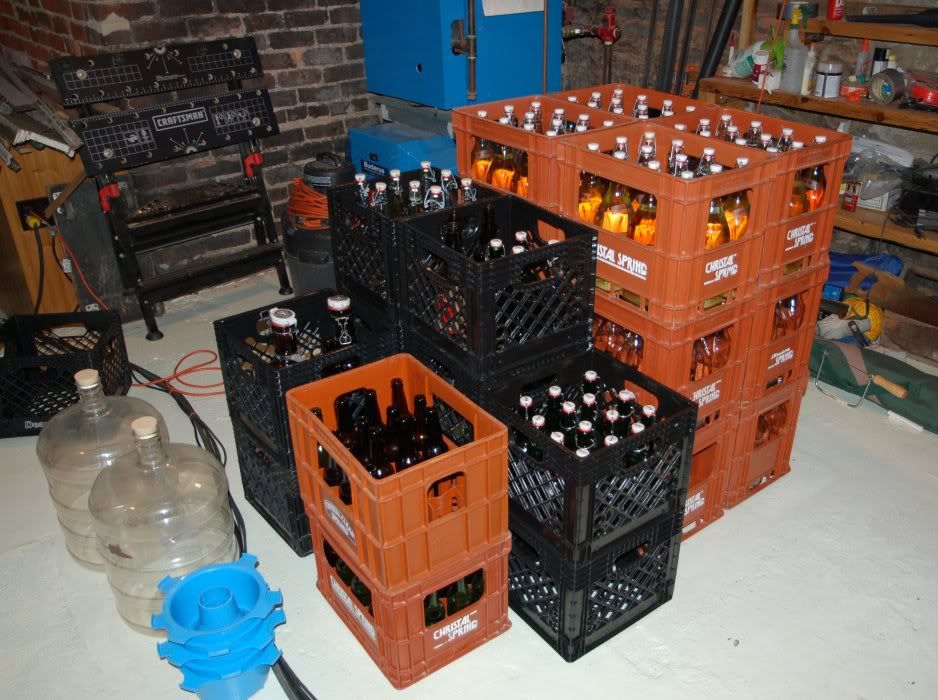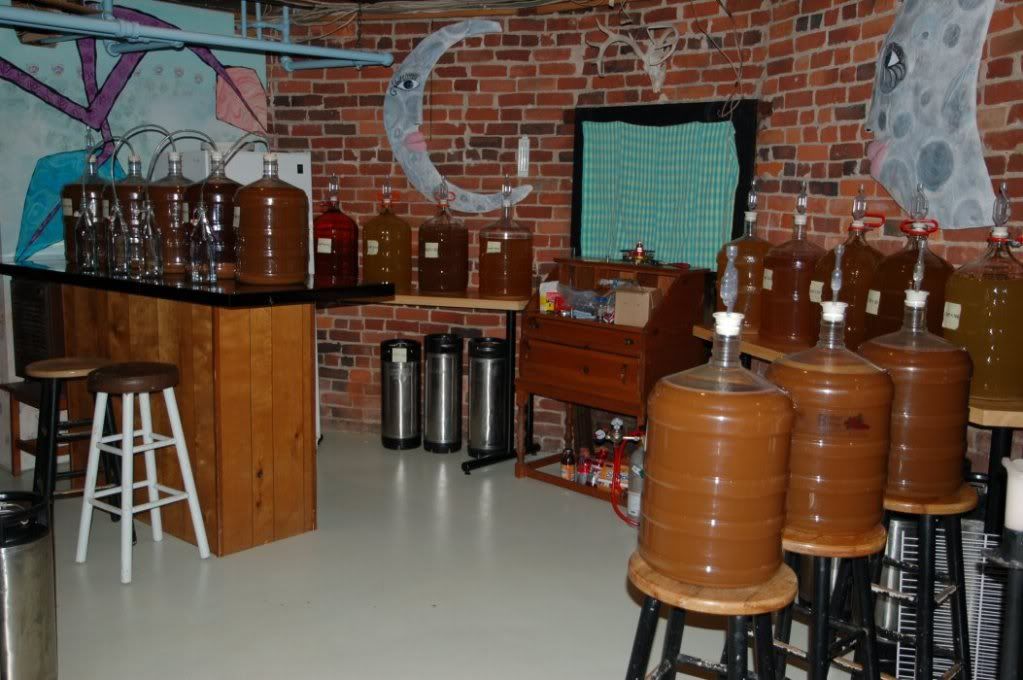Amazed at your ability to handle so much juice. The cleaning / sanitizing must take some time.
Having a pickup truck helps. It takes a bit of time, but not all that much more than doing a single carboy. A lot of time time is prep, making the trip to get the juice, etc. Crashing does take longer because that is a serial step for me, since I only have room in the fridge for one carboy at a time. The single gallon experimental batches probably take the longest because I tend to taste them more frequently and bottle them at the end vs kegging which is one reason Ive cut back on the experiments this year.
Have you considered going commercial with all this?
Yeah, Ive thought about it, but when I figured out how many kegs I would have to sell to quit my day gig, it didnt seem like such a good idea. Plus, the nice thing about working at this scale is that each batch is a little different, Im still learning a lot, and the homebrew party scene is a lot of fun. Once you go commercial, then success is all about consistency, scale, distribution, shelf life, branding, etc. I dont want to have to fool with all that.
Mind if I ask what you look for when you source your juice?
In my experience, what you want to look for is a nice spicy apple smell to start with, then a big sweet apple taste up front, with the sweetness fading but leaving a lot of apple flavor when its in your mouth and a tart finish. Ideally the flavor is almost too intense for drinking as table juice, except maybe for sipping. Probably the closest thing I got this year to an ideal mix was the Stayman, Pink Lady, Albemarle Pippen mix. I wish I could get that all year long.
Probably the main thing to look for if you are dealing with a commercial press is a press operator who either makes or likes hard cider and is keeping an eye out for good hard cider apples. One of the challenges of getting a good mix is that the apples ripen at different times, and depending on the market, not everything may be available as #2 cider grade apples, so you might have to get creative with whats available. If you dont mind paying full price for retail bushels and have your own press, then you can make great mixes all year long, but thats a bit more time and money. Also if you can, go to local apple festivals and taste apples. That is how I found out about the Albemarle Pippens (although it took me two years, until this season to find any #2s). This year my favorite was a Gold Rush, so I'll be looking for that one next year.
Happy New Year from the west coast!
Cheers from the Virginia Piedmont!
I picked up another 22 single gallons for some experiments on Friday. The juice was a mix of Fuji and Yellow Delicious not ideal but it was all that the press had on hand and I didnt have time to find another juice source. Its a good mix in most respects nice smell and a lot of apple flavor, but no tartness in the finish. The sg was 1.066 and the pH was 4.6. I thought I could compensate for the lack of finish by adding some acid blend so I added ½ teaspoon of LD Carlson Citric, Malic, Tartaric blend to a test gallon, but it didnt give me what I was looking for. It dropped the pH by a couple tenths and made the juice taste more tangy in the mouth, but didnt add anything to the finish and it stomped on the spicy part of the flavor. The juice was already tangy enough in the mouth, it just didnt have any tang in the finish. Not really much finish at all. Since the acid blend didnt really help that, I didnt use it. So lesson learned acid blend can provide more tang in the mouth if the juice is missing that, but it wont give you a nice finish if the juice doesnt already have one. It retrospect, I wish I had paid full price for a couple bushels of pippens to throw in the mix, but I think it will be OK. Im planning to let these go a little drier than usual, so that the little bit of acid that is in the juice will be more prominent. Time will tell if that works.

10 of the gallons are UV pasteurized. Im doing some experiments on different clearing agents with these, so I intentionally wanted something that would be harder to clear. So far, I havent ever used any clearing agents, and Im not sure that I ever will, but I wanted to check out the effects on the taste. Some of the batches from this year took longer to clear than usual, which is backing up the production. I added pectic enzyme to 5 of these, left the other 5 as-is. Using S04 on all 10. After the crash, Im going to use Bentonite, Super Klear, Isinglass and Sparkloid on each pair and do nothing to the other two. One of my reservations about using pectic enzyme is that the presense of pectin increases fusel alcohols. Dissolving the pectin might make the yeast consume more of it and could result in higher fusels. So at some point Im going to have to have to drink a liter or two with the pectic enzyme and compare the hangover to the same batch without the pectic enzyme. My only regret is that I have but one liver to give to science
. One thing I noticed already is that pectic enzyme is a bit of PIA to use. You need to sprinkle it in very slowly or else it gets all clumpy and the clumps are damn near impossible to break up with shaking.
The other 12 gallons are unpasteurized, no k-meta or any additives at all, with the following yeasts:
Wyeast 1084 Irish Ale
Wyeast 1728 Scottish Ale
Wyeast 2112 California Lager
Wyeast 1272 American Ale II
White Labs WLP023 Burton Ale
White Labs WLP028 Edinburgh Ale
White Labs WLP810 San Francisco Lager
White Labs WLP775 English Cider
WLP041 Pacific Ale
Brewferm Blanche (dry wheat yeast)
S04 (for a control on this batch of juice)
For the last gallon I pitched 3 dry british yeasts that were almost expired (Youngs Ale, Youngs Lager & Ritchie Ale), just to see what happens.





